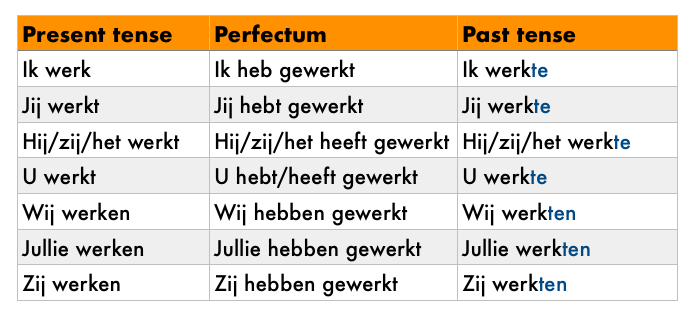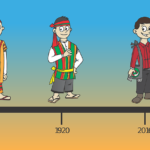The Dutch Past Tense With Weak And Strong Verbs. A worksheet on simple past, the past participle and the present perfect.
The Dutch Past Tense With Weak And Strong Verbs
The Dutch use the simple past tense to refer to an event that took place in the past.
Conjugation of a t-verb
| ik | [stem] + te | we | [stem] + ten |
| je | [stem] + te | jullie | [stem] + ten |
| hij | [stem] + te | ze | [stem] + ten |
Conjugation of a d-verb
| ik | [stem] + de | we | [stem] + den |
| je | [stem] + de | jullie | [stem] + den |
| hij | [stem] + de | ze | [stem] + den |
Examples
- merken (to notice) and wensen (to wish)
| merken | stem: merk | wensen | stem: wens |
| ik | merkte | ik | wenste |
| je | merkte | je | wenste |
| hij | merkte | hij | wenste |
| we | merkten | we | wensten |
| jullie | merkten | jullie | wensten |
| ze | merkten | ze | wensten |
Note the double ‘t’ in the conjugation of rusten and double ‘d’ in the conjugation of bloeden. You do not hear the double ‘d’ or ‘t’, but you do have to write it! Wij bloeden and wij bloedden are pronounced the same, but the first is the present tense, the latter the past.
- rusten (to rest) and bloeden (to bleed)
| rusten | stem: rust | bloeden | stem: bloed |
| ik | rustte | ik | bloedde |
| je | rustte | je | bloedde |
| hij | rustte | hij | bloedde |
| we | rustten | we | bloedden |
| jullie | rustten | jullie | bloedden |
| ze | rustten | ze | bloedden |
- luisteren (to listen) and kussen (to kiss)
| luisteren | stem: luister | kussen | stem: kus |
| ik | luisterde | ik | kuste |
| je | luisterde | je | kuste |
| hij | luisterde | hij | kuste |
| we | luisterden | we | kusten |
| jullie | luisterden | jullie | kusten |
| ze | luisterden | ze | kusten |
- roeien (to row) and lenen (to lend, to borrow)
| roeien | stem: roei | lenen | stem: leen |
| ik | roeide | ik | leende |
| je | roeide | je | leende |
| hij | roeide | hij | leende |
| we | roeiden | we | leenden |
| jullie | roeiden | jullie | leenden |
| ze | roeiden | ze | leenden |
For the perfect tense, they use a past participle.
To establish whether we are dealing with a t-verb or a d-verb, we have to look at the last letter of the verb stem. If this is t, h, f, c, k, s or p, (“pocket fish”) it is a t-verb, all other verbs are d-verbs.
past participle = ge + [stem] + t / d
Whether the past participle ends in a -t or -d depends of course on whether the verb is a t or a d-verb.
| maken | to make | stem: maak (t-verb) | past participle: ge + maak + t = gemaakt |
| luisteren | to listen | stem: luister (d-verb) | past participle: ge + luister + d = geluisterd |
In Dutch I have made becomes: ik heb gemaakt.
The ge + stem + t/d rule applies to most regular verbs, but there are also verbs that need an extra or different treatment.
For the perfect tense, they generally use the verb hebben (to have), just like in English: “You have worked”. For a few verbs we use zijn (to be).
| ik | heb/ben + pp | we | hebben/zijn + pp |
| je | hebt/bent + pp | jullie | hebben/zijn + pp |
| hij | heeft/is + pp | ze | hebben/zijn + pp |

A very useful web site is www.verbix.com. It conjugates Dutch verbs for you in all eight tenses.
Content
Level
This lesson can be used for adults from elementary to intermediate levels.
Aim
The aim of this lesson is to learn the past tenses in Dutch
Preparation
First print out the worksheet, then copy a worksheet for each student in the class.
Procedure
Go through the grammar and exercises together.








Useful information for learning the tenses in Dutch